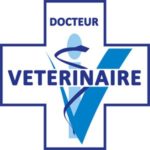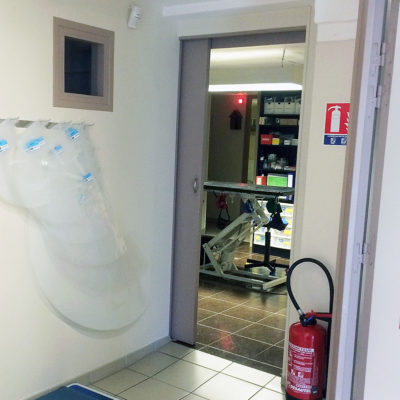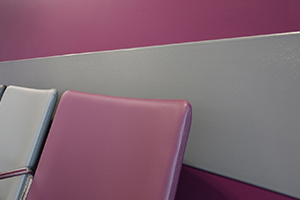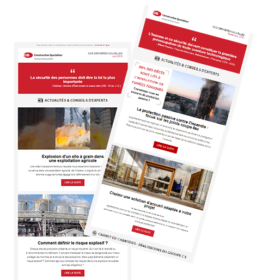
A national survey conducted in 2016 by FACCO/KANTAR-TNS reveals that 49.5% of French households own at least one pet, or almost one in two French households. The same study states that the population of pets in France is estimated at almost 63 million, almost equivalent to the French population. The need for veterinary care is increasing and the number of specialized practices is increasing. In 2017, according to the National Demographic Observatory of the Veterinary Profession, animal medicine and surgery are practiced in 8,050 specialized institutions.
Like traditional medical and hospital care, medical structures specialising in veterinary care require the application of the same strict hygiene protocols and the same codes of ethics. Providing a healthy environment at all times is essential and the result of continuous work. For this reason, the interior design must be studied according to the constraints encountered. And it is not so easy to keep a clean environment when patients are furry and feathered…..
The design of buildings must integrate multiple criteria, such as impeccable hygiene to guarantee the safety of veterinary procedures, choosing resistant and durable finishes without neglecting the appearance of the premises to make them welcoming.
What are the ways to protect the structure of a veterinary practice and keep it in its original state over time? Do all areas of the facility have the same finishing necessities?
Space by space, let us take a look at the existing means of preserving and protecting a building that cares for and shelters animals.

1. Maintain clean common spaces
The reception, waiting rooms and corridors of a veterinary clinic see a large number of animal species, from cats to mice and iguanas. This diversity allows each new entry into the practice to create a probable confrontation between the most aggressive animals and increases stress before the most frightened animals are examined.
These behaviours are self-maintaining and induced by the highly developed sense of smell of the animals. This ever-aware sense is all the more sensitive to alarm pheromones released by the animal’s state of panic. This defensive cognitive function signals the presence of a predator to other members of a species with a clear olfactory message. The instinct and behaviour of the animal are directly affected by this vicious circle, which is difficult for the staff of the veterinary structure to control.
Additional emotional vectors such as the previous journey and the pain the animal may feel, if the purpose of the visit is not a routine examination, also lead to incidents in the common areas of the offices such as repeated droppings, regurgitation or urine jets.
To avoid the consequences of its constraints and limit them as much as possible, it is advisable to opt for non-porous joinery and interior frames that are easily washable and resistant to strong and corrosive disinfectants.
Acrovyn® wall panels have been developed for environments where hygiene is a requirement. The material prevents the growth of bacteria and is very easy to wash. Tinted in the mass and waterproof, Acrovyn® plates can withstand steam cleaning and daily washing cycles required in the medical environment.
2. A clean operating room in every corner
During hospitalizations and surgical procedures, the operating room but also the preparation and convalescence environments of the animals must be protected as much as possible against the risks of nosocomial and post-operative infections. Choosing materials that are non-porous and disinfectant is essential.
The smooth and inert surface of stainless steel wall coverings prevents, for example, the growth of bacteria and mould. Even more effective, Acrovyn® Bactericide wall protection panels have the ability to kill bacteria by simple contact. This unique wall covering ensures that the spaces are protected from bacteria, viruses or germs that cause infections. Their implementation side by side using silicone gaskets reinforces the microbial barrier.
3. Prevent the risk of transmission in corridors and consultation rooms
Many animals can carry pathogens that can be transmitted to humans. These diseases and infections, zoonoses are classified according to their type according to the pathogen and the mode of transmission. To cite a few examples, the most well-known zoonoses are tuberculosis, toxoplasmosis, lyme disease, scabies, or tetanus.
When the parasite is inoculated by contact, it is necessary to be vigilant in the design of the layout and anticipate the path of an animal carrying pathogens inside the practice.
For example, animals that are not transported in crates, such as dogs, tend to shave the walls from the entrance to the consultation room. This behaviour is related to the animal’s stress but also to its instinct. It thus marks its territory. This mimetic character developed by some animal species increases the risk of contamination between animals by a simple contact with the walls. The kennel boxes and the hospitalization area must also address this type of contamination when designing them.
Consultation rooms and corridors are also subject to other recurrent animal behaviours that should be anticipated. For example, after a diagnosis, veterinarians often administer the first dose of the treatment or a disinfectant solution. If it is an ear solution, the animal’s reflex is irrefutable: it shakes its head vigorously and projections still infected are observed on the walls and floors.
To minimize the risk of transmission to caregivers, owners and also to pets visiting the practice, it is equally appropriate for these areas to apply strict hygiene protocols and this is only possible with washable wall and floor coverings. Choosing to protect the walls at their lower half height with specific and robust coatings, such as wall protection panels, is once again practical, safe and hygienic.
4. Maintain the appearance of new premises for a long time

In addition to the health requirements of a medical profession, maintaining clean and impeccable premises in the eyes of the owners also determines the image of the firm and contributes to their confidence in it. It is even a master’s main evaluation indicator to assess at a glance the quality of the firm and the rigour applied within the institution.
However, the walls of the common areas of a veterinary clinic (corridors, waiting rooms, kennels, etc.) are subjected to severe tests. Under the influence of panic and fear, animals can struggle and leashes can hit the walls. And this must also take into account the fact that many transport crates, which are more or less bulky, use the same passage and cause visible wall damage when they collide with the walls. These more or less intense frictions elite the plaster and wall paint on the surface at the height of the passage. The aesthetics and image of the firm are immediately and irreparably damaged. If, when designing the cabinet, wall protections such as bumpers on non-porous wall coverings are used, the risk of wall damage is eliminated.
5. Decorate the space
Although the perception of colours in animals is different from ours, some colours affect animal behaviour in the same way as in humans. Each colour spectrum, visible or not, contains an electromagnetic wave that is perceived and transcribed by the eyes and brain. Dogs and cats can’t distinguish red. However, this shade enhances the aggressiveness of cats. They are more sensitive to colours such as blue and yellow. According to animal behaviourist Marie-Hélène Bonnet, yellow stimulates the appetite of older animals and blues or purples tend to soothe and calm animals.
It is essential to consider that the daily working environment of health workers and veterinarians. It is a demanding job in terms of emotional aspect and decoration and the colours chosen also contribute to the development and quality of life at work of all the establishment’s staff.
Discover the Acrovyn colour chart and the many shades available
